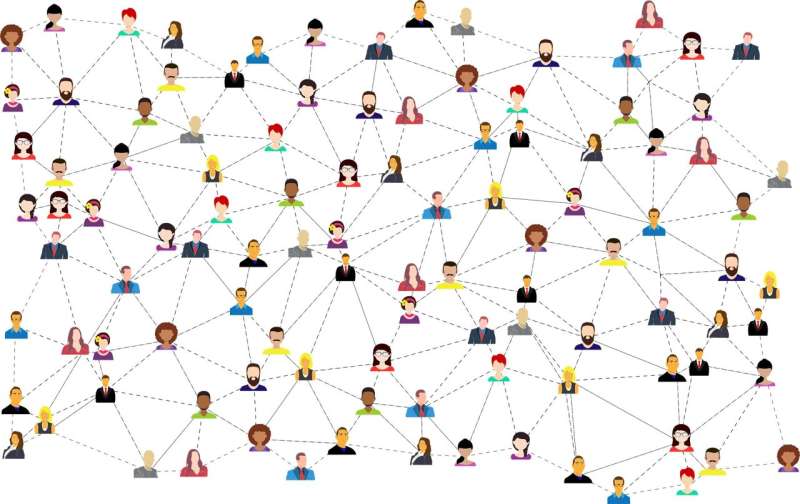Study finds links between lockdowns and decreasing social network segregation
Ph.D. candidate Ludovico Napoli and Associate Professor Márton Karsai from the Department of Network and Data Science at Central European University (CEU) recently published a paper titled “Socioeconomic reorganization of communication and mobility networks in response to external shocks” in the Proceedings of the National Academy of Sciences (PNAS). This collaborative effort with UNICEF and the IT University of Copenhagen sheds light on the profound changes in network segregation patterns during the initial wave of COVID-19 in Sierra Leone.
The study leverages large-scale mobile phone communication data to simultaneously explore the effects of non-pharmaceutical interventions on mobility and social communication networks. Surprisingly, while mobility networks became more segregated during lockdown due to travel restrictions, social communication networks became less segregated, connecting individuals across diverse socioeconomic backgrounds.
“These opposite and counterintuitive trends in mobility and social behaviors suggest that with physical contact restricted, people compensated by communicating more with peers from different socioeconomic classes,” said Professor Karsai.
Notably, the research revealed varying impacts across socioeconomic groups, indicating that the lockdown effects were not uniform. While everyone experienced increased mobility segregation, the rise was significantly more pronounced and enduring for poorer socioeconomic classes. In social communication networks, a contrasting trend emerged, with decreased segregation for poorer individuals and increased segregation for wealthier.
In the paper, the authors emphasize the necessity of examining multiple behavioral dimensions simultaneously during crises to comprehensively uncover the effects of non-pharmaceutical interventions. Their findings underscore the importance of shaping equitable policies to address the unequal burden of interventions on economically disadvantaged populations.
More information:
Ludovico Napoli et al, Socioeconomic reorganization of communication and mobility networks in response to external shocks, Proceedings of the National Academy of Sciences (2023). DOI: 10.1073/pnas.2305285120
Provided by
Central European University
Citation:
Study finds links between lockdowns and decreasing social network segregation (2023, December 22)
retrieved 22 December 2023
from https://phys.org/news/2023-12-links-lockdowns-decreasing-social-network.html
This document is subject to copyright. Apart from any fair dealing for the purpose of private study or research, no
part may be reproduced without the written permission. The content is provided for information purposes only.

Ph.D. candidate Ludovico Napoli and Associate Professor Márton Karsai from the Department of Network and Data Science at Central European University (CEU) recently published a paper titled “Socioeconomic reorganization of communication and mobility networks in response to external shocks” in the Proceedings of the National Academy of Sciences (PNAS). This collaborative effort with UNICEF and the IT University of Copenhagen sheds light on the profound changes in network segregation patterns during the initial wave of COVID-19 in Sierra Leone.
The study leverages large-scale mobile phone communication data to simultaneously explore the effects of non-pharmaceutical interventions on mobility and social communication networks. Surprisingly, while mobility networks became more segregated during lockdown due to travel restrictions, social communication networks became less segregated, connecting individuals across diverse socioeconomic backgrounds.
“These opposite and counterintuitive trends in mobility and social behaviors suggest that with physical contact restricted, people compensated by communicating more with peers from different socioeconomic classes,” said Professor Karsai.
Notably, the research revealed varying impacts across socioeconomic groups, indicating that the lockdown effects were not uniform. While everyone experienced increased mobility segregation, the rise was significantly more pronounced and enduring for poorer socioeconomic classes. In social communication networks, a contrasting trend emerged, with decreased segregation for poorer individuals and increased segregation for wealthier.
In the paper, the authors emphasize the necessity of examining multiple behavioral dimensions simultaneously during crises to comprehensively uncover the effects of non-pharmaceutical interventions. Their findings underscore the importance of shaping equitable policies to address the unequal burden of interventions on economically disadvantaged populations.
More information:
Ludovico Napoli et al, Socioeconomic reorganization of communication and mobility networks in response to external shocks, Proceedings of the National Academy of Sciences (2023). DOI: 10.1073/pnas.2305285120
Provided by
Central European University
Citation:
Study finds links between lockdowns and decreasing social network segregation (2023, December 22)
retrieved 22 December 2023
from https://phys.org/news/2023-12-links-lockdowns-decreasing-social-network.html
This document is subject to copyright. Apart from any fair dealing for the purpose of private study or research, no
part may be reproduced without the written permission. The content is provided for information purposes only.
